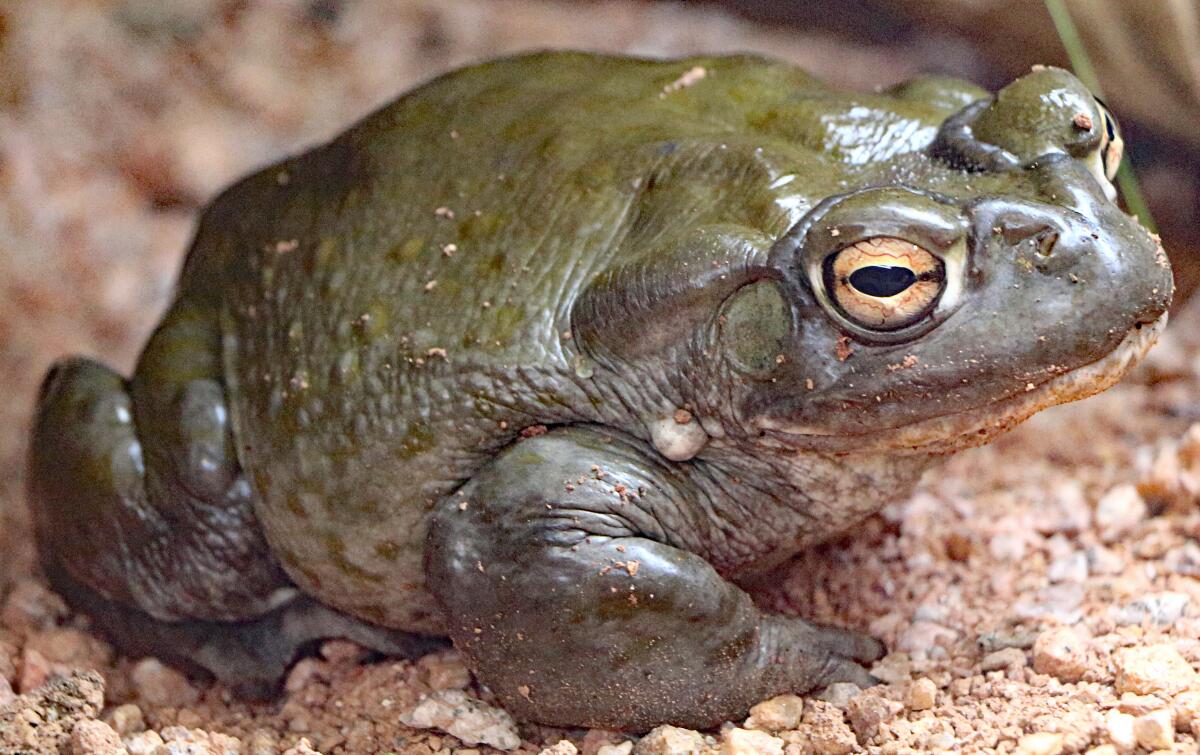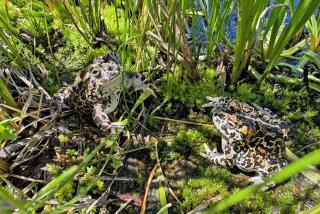Have fun outside, but please don’t lick the hallucinogenic toads, National Park Service says

- Share via
The National Park Service has a few simple requests for its guests who want to enjoy the outdoors: Pick up your trash, be mindful of your campfires, and please don’t lick the Sonoran Desert toads.
The golden-eyed toads are roughly 7 inches long and emit a weak, low-pitched cry that can be compared to a “toot,” according to the National Park Service in a public service announcement the agency made on Halloween. The agency asked guests not to lick the toad’s potent toxin, which carries hallucinogenic properties.
The toxin is strong enough to make a person sick if they touch it or if they somehow get the toxin into their mouth — perhaps via their tongue.
“As we say with most things you come across in a national park, whether it be a banana slug, unfamiliar mushroom, or a large toad with glowing eyes in the dead of night, please refrain from licking,” the agency said in a Facebook post that has now gone viral.
Veterinarians warn pet owners that dogs and cats can die if they lick the toad’s toxins and do not receive immediate medical help.
Although the National Park Service’s advice seems out of left field, this isn’t the first time a government agency has asked the public to fight the urge to lick a toad.
In 1990, the DEA warned Americans about the growing trend of toad-licking, but the concern at the time was centered on cane toads.
“It sounds like a fairy tale gone wrong, doesn’t it?” Robert Sager, then chief of the DEA’s laboratory in San Francisco, told The Times. “Now, I don’t think this is going to be a great problem because people don’t go around licking toads as a habit.”
In 1993, the South Carolina Legislature introduced a bill that would later fail to pass but sought to make it illegal “to lick, kiss or bite a cane toad or to engage in the act of toad-smoking.” Offenders found guilty of the crime would have served 30 days’ community service at a reptile house at the Columbia Zoo, according to the state’s archives.
The National Park Service took on a more tongue-in-cheek tone with a Facebook post that featured an unaware Sonoran toad gazing in a night-vision photo.
“Black and white motion sensor camera capture of Sonoran Desert Toad staring into your soul at Organ Pipe Cactus National Monument, Arizona,” the caption read.
The toad is native to the Sonoran desert, but also found in the lower Colorado River and in the southeast area of Imperial County bordering Arizona. The frogs tend to emerge during the monsoon season and are most active from March to July.
Also known as the Colorado River toad or bufo alvarius, the animal secretes the hallucinogen 5-MeO-DMT, according to a 2019 study from Maastricht University in the Netherlands. The study analyzed the effects of inhaling the vapor of dried toad secretion from the parotid gland, which is found near the toad’s eyes. The act of inhaling the vapor has gained popularity in naturalistic settings as a treatment for anxiety, depression or other mental health issues. The toxin is also used by people who want to hallucinate for spiritual purposes.
In popular culture, toad-licking has become a shortcut for a psychedelic trip. In Isaac Asimov’s 1954 sci-fi novel, “Lucky Starr and the Oceans of Venus,” small frogs entrance humans with telepathy, while in the animated series “Futurama” a recurring character named the “Hypnotoad” mesmerizes anyone who stares into its undulating eyes.
More to Read
Sign up for Essential California
The most important California stories and recommendations in your inbox every morning.
You may occasionally receive promotional content from the Los Angeles Times.










